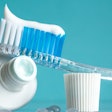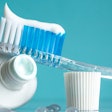
Do you remember the days when toothpaste was just toothpaste? The days when, so long as it had fluoride in it, it was good?
Maybe it's just me, but doesn't it feel like between the big brand players who have been in the game forever and the new kids on the block that we have a toothpaste for everything?
 David Rice, DDS.
David Rice, DDS.- Toothpastes for caries risk
- Toothpastes for tissue issues
- Toothpastes that whiten
- Toothpastes that brighten
- Toothpastes that strengthen your bite
All of a sudden, toothpastes are like Hallmark holidays.
It's not my aim to underplay the value of all of the above. Very appropriately, toothpastes have become targeted, and toothpastes have also become dialed into risk. That part makes sense, right? If a patient lacks decay and their tissue is an issue, we know where to go. Likewise, if the periodontal tissues are stable and we have high caries risk, again, we know where to go.
One risk
That said, too many options tend to introduce too much confusion. Too much confusion leads to too much indecision. Too much indecision leads to defaulting to our old ways.
Another risk
Whether our patients have a high risk for decay or a high risk for periodontal issues, there's a universal risk that often gets overlooked that I'd like us to focus on today: relative dentin abrasivity (RDA).
What's the translation for RDA? It is how damaging a toothpaste is to our patients' teeth.
This, my friends, is a very different risk. It's not the risk that disease brings to our patients. It's the de facto risk we bring to our patients with the daily regimen we prescribe.
The 60,000-foot view is the ADA and friends determined that, ideally, the RDA of a toothpaste should be 70 or below. The 30,000-foot view is, outside of brushing with plain water, the next lowest RDA value of 7 came in with what I imagine will be as surprising to you as it was to me -- plain baking soda.
Now there are some usual suspects below 70 that you and I would expect:
- Pronamel by Sensodyne (GlaxoSmithKline)
- Clinpro (3M)
- A few toothpastes by Colgate
On the other extreme, however, falling within a range from 151 to 250 RDA (or what the ADA considers "harmful"), there are some pretty commonly talked about toothpastes. This includes Crest's Pro-Health Whitening at 162, Colgate's Tartar Control that rolls in with an RDA of 165, one of Arm & Hammer's pastes (an Amazon favorite) at 168. Additionally, Nature's Gate toothpaste has an RDA of 176, and Colgate's 2-in-1 tartar control comes in at 200, which is the U.S. Food and Drug Administration's upper limit.
It's pretty clear that we have major extremes happening out there. It's also pretty clear that we don't talk about this enough. Our patients need our help. Yes, some of those patients need caries control. Some need periodontal help. Some need both.
Equally true, our patients need us to get informed. We have to stop letting the 15-year-old in the local grocery store or pharmacy give advice. We have to start recommending with knowledge and conviction.
Check out the RDA list here. If you see a paste you recommend on there, make sure it falls in the recommended range. If you don't find your go-to, I'd strongly recommend asking your rep for the data and the research behind it.
It's time to become educated for our patients' sake. After all, toothpaste is no longer just toothpaste.
The comments and observations expressed herein do not necessarily reflect the opinions of DrBicuspid.com, nor should they be construed as an endorsement or admonishment of any particular idea, vendor, or organization.


















